
Afro-Cubans (Afro-Cubanos) are Cubans who are mostly of Sub-Saharan African ancestry. The term Afro-Cubans includes the historical or cultural elements in Cuba thought to emanate from this community as well as the combining of African and other cultural elements found in Cuban society such as race, religion, music, language, the arts, and class culture.
Unlike other Latin American countries where African descendants can be found in particular region with the state, Afro-Cubans on the other hand can be found in every corner of Cuba. However, Eastern Cuba has a higher concentration of blacks than other parts of the island, and Havana has the largest population of blacks of any city in Cuba. Recently, many African immigrants have been coming to Cuba, especially from Angola. Also, immigrants from Jamaica and Haiti have been settling in Cuba, most of whom settle in the eastern part of the island, due to its proximity to their home country, further contributing to the already high percentage of blacks on that side of the island.
It must be emphasized that until the last decades of the 18th Century, Cuba was a relatively underdeveloped island with an economy based mainly on cattle raising and tobacco farms. The intensive cultivation of sugar that began at the turn of the nineteenth century transformed Cuba into a plantation society, and the demand for African slaves, who had been introduced into Cuba from Spain at the beginning of the 16th century, increased dramatically. Afro-Cubans are descendants of diverse African ethnic groups shipped to Cuba to cultivate the sugarcane plantation thereby enriching the European capitalists.
The enslaved Africans were from ports of Elmina, Pepper Coast, Dahomey, bight of Biafra, and Central and East African ports. The ethnic groups that formed the core parts of the enslaved Africans were particularly Yoruba (or Lucumi), Igbo and Kongo (Bantu people), but also Arará (Ewe, Fon, Aja, Mina), Carabalí (Efik, Ibibio, Ekoi, Annang), Mandingo, Fula (Fulani/Fulbe), Makua, Mina (Akans, and other Gold Coast slaves) and others.
The shipment of Africans into slavery in Cuba, especially transportation of slaves from the West African coast exploded, and it is estimated that almost 400,000 Africans were brought to Cuba during the years 1835-1864. (That’s roughly 1150 per month for 29 years!) As early as 1532, the blacks formed 62.5 percent of the population. In 1841, African slaves made up over 40% of the total population.
BY: Kweku Darko Ankrah
